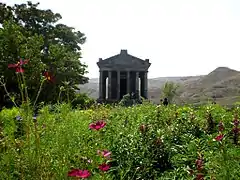Temple of Garni
The Temple of Garni (Armenian: Գառնիի տաճար,[4] Gaṙnii tačar, [ˈgɑrnii ˈtɑtʃɑʁ])[lower-alpha 1] is the only standing Greco-Roman colonnaded building in Armenia and the former Soviet Union. Built in the Ionic order in the village of Garni, Armenia, it is the best-known structure and symbol of pre-Christian Armenia.
| Temple of Garni | |
|---|---|
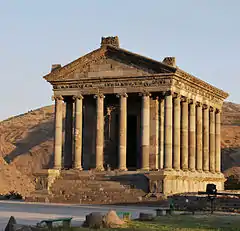 The temple in 2013 | |
 Location within Armenia | |
| General information | |
| Status | Museum (as part of a larger protected area) occasional Hetanist (neopagan) shrine |
| Type | Pagan temple and tomb[1][2] |
| Architectural style | Ancient Greek, Greco-Roman |
| Location | Garni, Kotayk Province, Armenia |
| Coordinates | 40.112421°N 44.730277°E |
| Elevation | 1,396 m (4,580 ft)[3] |
| Completed | First or second century AD[1] |
| Owner | Armenian Ministry of Culture |
The structure was probably built by king Tiridates I in the first century AD as a temple to the sun god Mihr. After Armenia's conversion to Christianity in the early fourth century, it was converted into a royal summer house of Khosrovidukht, the sister of Tiridates III. According to some scholars it was not a temple but a tomb and thus survived the destruction of pagan structures. It collapsed in a 1679 earthquake. Renewed interest in the 19th century led to excavations at the site in early and mid-20th century, and its eventual reconstruction between 1969 and 1975, using the anastylosis method. It is one of the main tourist attractions in Armenia and the central shrine of Hetanism (Armenian neopaganism).
Location
The temple is at the edge of a triangular cliff which overlooks the ravine of the Azat River and the Gegham mountains.[5] It is a part of the fortress of Garni,[lower-alpha 2] one of the oldest fortresses in Armenia,[6] that was strategically significant for the defense of the major cities in the Ararat plain.[5] It is mentioned as Gorneas in the first-century Annals of Tacitus.[7] The site is in the village of Garni, in Armenia's Kotayk Province and includes the temple, a Roman bath with a partly preserved mosaic floor with a Greek inscription,[8] a royal summer palace, the seventh century church of St. Sion and other minor items (e.g., medieval khachkars).[9]
History
Foundation
The precise construction date of the temple is unknown and is subject to debate. The dominant view is that it was built in 77 AD, during the reign of king Tiridates I of Armenia.[10] The date is calculated based on a Greek inscription,[lower-alpha 3] discovered by Martiros Saryan, a prominent artist, in July 1945 at the Garni cemetery, recently brought from a nearby water mill.[11][12] It names Tiridates the Sun (Helios Tiridates) as the founder of the temple.[5][13] The following includes an image of the inscription as it stands near the temple today, its textual reconstruction by Ashot G. Abrahamian,[14] an English translation by James R. Russell,[15] an alternative reading and translation by Poghos Ananian, as cited by Vrej Nersessian.[16]
| Image | Greek text[14] | Translation by Russell[17] | Alternative translation[16] |
|---|---|---|---|
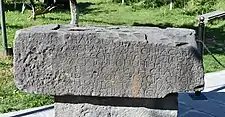  |
Ἣλιος Τιριδάτης [ὁ μέγας] μεγάλης Ἀρμενίας ἄνα[κτος] ὡς δεσπότης. Αἴκτισε ναΐ[διον] βασιλίσ[σ]α τὸν ἀνίκητον κασ[ιν ἐνι] αιτούς. Αι. Τῆς βασιλεί[ας αὐτου] με[γαλείας]. Ὑπὸ ἐξουσίᾳ στεγάν[ου] λίτουργος τῷ μεγάλῳ σπ[ῆι εὔχεσθε] μετὰ ματήμι καὶ εὐχαρ[ιστίαν εὐχήν] τοῦ μαρτυρίου. |
The Sun Tiridatēs of Greater Armenia, lord as despot, built a temple for the queen; the invincible... in the eleventh year of his reign. ...Under the protection of the... may the priest to the great cave (?) in the vain (?) of the witness and thanks. |
The Sun God Tiridates, uncontested king of Great Armenia built the temple and the impregnable fortress in the eleventh year of his reign when Mennieay was hazarapet [chiliarch] and Amateay was sparapet [commander]. |
Most scholars now attribute the inscription to Tiridates I. Considering that the inscription says the temple was built in the eleventh year of reign of Tiridates I, the temple is believed to have been completed in 77 AD.[18][lower-alpha 4] The date is primarily linked to Tiridates I's visit to Rome in 66 AD, where he was crowned by Roman emperor Nero.[lower-alpha 5] To rebuild the city of Artaxata, destroyed by the Roman general Gnaeus Domitius Corbulo, Nero gave Tiridates 50 million drachmas and provided him with Roman craftsmen. Upon his return to Armenia Tiridates began a major project of reconstruction, which included rebuilding the fortified city of Garni. It is during this period that the temple is thought to have been built.[23]
The temple is commonly attributed to Mihr,[7][24][25] the sun god in the Zoroastrian-influenced Armenian mythology and the equivalent of Mithra. Tiridates, like other Armenian monarchs, considered Mihr their patron. Some scholars have argued that, given the historical context during which the temple was built, i.e. after returning from Rome as king, it would seem natural that Tiridates dedicated the temple to his patron god.[23] Furthermore, white marble sculptures of bull hooves have been discovered some 20 metres (66 ft) from the temple which could possibly be the remains of a sculpture of the god Mihr, who was often portrayed in a fight with a bull.[26]
Alternative theories
Arshak Fetvadjian described the temple as an "edifice of Roman style for the pantheistic idol cult fashionable in the days of the Arshakists."[27] In 1950 Kamilla Trever reported that according to a different interpretation of the extant literature and the evidence provided by coinage, the erection of the temple started in 115 AD. The pretext for its construction would have been the declaration of Armenia as a Roman province[18] and the temple would have housed the imperial effigy of Trajan.[28]
An alternative theory proposed by Richard D. Wilkinson in 1982 suggests that the building is a tomb, probably constructed circa 175 AD. This theory is based on a comparison to Graeco-Roman buildings of western Asia Minor (e.g. Nereid Monument, Belevi Mausoleum, Mausoleum at Halicarnassus),[7] the discovery of nearby graves that date to about that time, and the discovery of a few marble pieces of the Asiatic sarcophagus style. Wilkinson furthermore states that there is no direct evidence linking the structure to Mithras or Mihr, and that the Greek inscription attributed to Tiridates I probably refers to a former fortress at the Garni site and not to the colonnaded structure now called the Temple of Garni. He also notes that it is unlikely that a pagan temple would survive destruction during Armenia's 4th-century conversion to Christianity when all other such temples were destroyed. Wilkinson offers the suggestion that the structure may be a tomb erected in honor of one of the Romanized kings of Armenia of the late 2nd century.[29][10]
James R. Russell finds the view of the structure being a temple of Mihr baseless. He is also skeptical that the Greek inscription refers to the temple.[30]
Christina Maranci calls it an Ionic structure with an "unclear function." She writes that "while often identified as temple, it may have been a funerary monument, perhaps serving as a royal tomb." She also notes that its entablature is similar to that of the temple of Antonius Pius at Sagalassos in western Asia Minor and to the columns of Attalia. She concludes that imperial Roman workmen may have been involved in its construction.[31]
Christian period
In the early fourth century,[lower-alpha 6] when Armenian King Tiridates III adopted Christianity as a state religion, virtually all known pagan places of worship were destroyed.[37] The Temple of Garni is the only pagan,[lower-alpha 7] Hellenistic,[24][42] and Greco-Roman[43] structure to have survived the widespread destruction. It remains unknown why the temple was exempted from destruction, but philosopher Grigor Tananyan argues that its status as a "masterpiece of art" possibly saved it from destruction. He suggests that the temple was perceived to be a "quintessence of an entire culture."[44] Robert H. Hewsen suggested that the reason why it was not destroyed is because it was not a temple, but a tomb of a Roman-appointed king of Armenia. He also noted that in the seventh century a church was built immediately next to it and not in its place.[6]
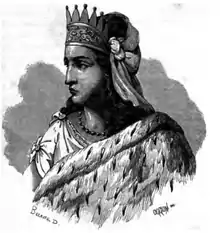
According to Movses Khorenatsi a "cooling-off house" (summer house) was built within the fortress of Garni for Khosrovidukht, the sister of Tiridates III.[5][41] As its purpose changed the temple underwent some changes. The sacrificial altars in the outside of the temple and the cult statue in the cella were removed. The opening in the roof for skylight was closed. The stone structures for removal of water from the roof were also removed, while the entrance of the temple was transformed and adjusted for residence.[44]
There is a series of Arabic graffiti on the walls of the temple, dated 9th-10th centuries.[10] There is also an Armenian inscription on the entrance wall of the temple. Dated 1291, it was left by princess Khoshak of Garni, the granddaughter of Ivane Zakarian (commander of Georgian-Armenian forces earlier in the 13th century) and Khoshak's son, Amir Zakare. It tells about the release of the population of Garni from taxes in forms of wine, goats, and sheep.[45] Simeon of Aparan, a poet and educator, made the last written record about the temple before its collapse in his 1593 poem titled "Lamentation on the throne of Trdat" («Ողբանք ի վերայ թախթին Տրդատայ թագաւորին»).[46][47]
Collapse
The entire colonnade of the temple collapsed in a devastating June 4,[48] 1679 earthquake,[49] the epicenter of which was, according to many scholars,[50] located in the gorge of Garni.[51] Most of the original building blocks remained scattered at the site, allowing the building to be reconstructed. As much as 80% of the original masonry and ornamental friezes were in the site by the late 1960s.[52]
European travellers mentioned the temple in their works as early as the 17th century.[1] Jean Chardin (1673, who visited Armenia before the earthquake) and James Morier (1810s)[53] both incorrectly described it through local informants since they never actually visited the site.[7] Upon Robert Ker Porter's visit the fortress was called "Tackt-i-Tiridate" ("throne of Tiridates" in Persian) by the locals. Ker Porter described what he saw as follows: "a confused pile beautiful fragments; columns, architraves, capitals, friezes, all mingled together in broken disorder."[7][54] Another European to visit and document the ruins of the temple was DuBois de Montpereux, who referred to the fortress as "Takh Terdat".[7] In his 1839 book he proposed a reconstruction plan.[7]
 Robert Ker Porter's drawing of the Garni Gorge (published in 1821).[55] Ruins of the temple can be seen on the promontory on the left.[7]
Robert Ker Porter's drawing of the Garni Gorge (published in 1821).[55] Ruins of the temple can be seen on the promontory on the left.[7].jpg.webp) Porter's drawing the temple's ruins[56]
Porter's drawing the temple's ruins[56]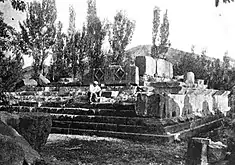
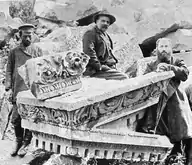 Toros Toramanian pictured sitting on part of the pediment[59]
Toros Toramanian pictured sitting on part of the pediment[59]

Reconstruction
The archaeologist Aleksey Uvarov proposed putting de Montpereux's plan into action at the fifth All-Russian Archaeological Congress in 1880. He proposed that the temple's stones be moved to Tiflis (in Georgia) and be reconstructed there according to de Montpereux's plan.[60] Lori Khatchadourian suggests that the plan "could be read as an attempt at co-opting Armenia's Roman past to the glory of Russia through the relocation of its most iconic monument to the nearest administrative center."[60] The governor of Erivan, citing technical difficulties, did not implement the plan.[61]
In the subsequent decades scholars such as Nikoghayos Buniatian, Babken Arakelyan, and Nikolay Tokarsky studied the temple.[44] In 1909–11, during an excavation led by Nicholas Marr, the temple ruins were uncovered. Buniatian sought to reconstruct the temple in the 1930s.[61]
In 1949 the Armenian Academy of Sciences began major excavations of the Garni fortress site led by Babken Arakelyan. Architectural historian Alexander Sahinian focused on the temple itself. It was not until almost twenty years later, on December 10, 1968, that the Soviet Armenian government approved the reconstruction plan of the temple. A group led by Sahinian began reconstruction works in January 1969. It was completed by 1975,[62] almost 300 years after it was destroyed in an earthquake.[24][63] The temple was almost entirely rebuilt using its original stones, except the missing pieces which were filled with blank stones intended to be easily recognisable.[61] In 1978 a monument dedicated to Sahinian was erected not far from the temple.[63]
Architecture
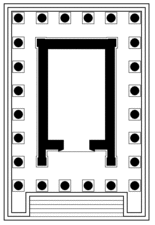 Ground plan
Ground plan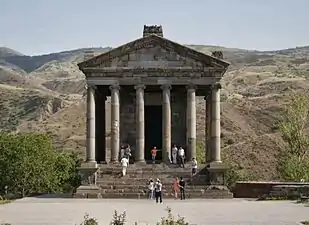 Front view
Front view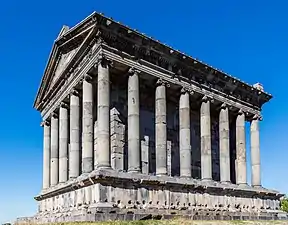 Side view
Side view Rear view
Rear view
Overview
The temple follows the style of classical Ancient Greek architecture which began developing in the seventh century BC.[64] Scholars have variously described the structure as Greek, Roman or Greco-Roman and have usually linked it to Hellenistic art, often pointing out its distinct features and local Armenian influence.[65] Some scholars have emphasized the Armenian influence on its architecture, calling it "Armenian-Hellenic" (Sahinian), while others have completely dismissed this view, calling it a "foreign structure on Armenian soil".[66] Toros Toramanian, for instance, stressed the singularity of the temple as a Roman-style building on the Armenian Highlands and "remarked that the Garni construction essentially had no influence on contemporary or subsequent Armenian architecture."[67] Sahinian, on the other hand, called it a "product of the architectural-constructional art of the Hellenistic period" that entirely resembles the 9th century BC Urartian Musasir temple.[68]
The temple is a peripteros built on an elevated podium.[69][61] It is constructed of grey basalt quarried locally[69][7] and without the use of mortar.[4][31] The blocks are instead bound together by iron and bronze clamps.[31] The temple is composed of a portico (pronaos) and a cella (naos). The temple is supported by a total of twenty-four 6.54-metre (21.5 ft) high columns of the Ionic order: six in the front and back and eight on the sides (the corner columns are listed twice).[69][64] Based on a comparative analysis Sahinian proposed that the columns of the temple of Garni have their origins in Asia Minor.[70]
Exterior
The triangular pediment depicts sculptures of plants and geometrical figures.[71] The staircase has nine[61] unusually high steps—30 centimetres (12 in) high, about twice as high as the average height of stairs.[71] Tananyan suggests that the unusually high stairs compel a person ascending the staircase to feel humbled and make physical effort to reach the altar.[71] On the both sides of the staircase there are roughly square pedestals. Atlas, the Greek mythological Titan who held up the earth, is sculpted on both pedestals in a way seemingly trying to hold the entire temple on its shoulders. It is assumed that, originally, pedestals held up altars (sacrificial tables).[71]
The exterior of the temple is richly decorated. The frieze depicts a continuous line of acanthus. Furthermore, there are ornaments on the capital, architrave, and soffit. The stones in the front cornice have projecting sculptures of lion heads.[26] A fragment of the architrave bearing a lion head was removed by Captain J Buchan Telfer in the late nineteenth century and bequeathed by him to the British Museum in 1907.[72]
 Fragment of frieze
Fragment of frieze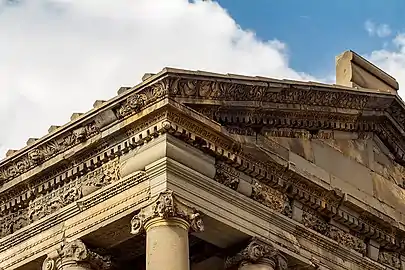
.jpg.webp)
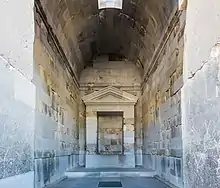
Cella
The cella of the temple is 7.132 metres (23.40 ft) high, 7.98 metres (26.2 ft) long, and 5.05 metres (16.6 ft) wide.[71] Up to 20 people can fit inside the cella.[73] Due to the relatively small size of the cella, it has been proposed that a statue once stood inside and the ceremonies were held in the outside.[26] The cella is lit from two sources: the disproportionately large entrance of 2.29 by 4.68 metres (7 ft 6 in by 15 ft 4 in) and the opening in the roof of 1.74 by 1.26 metres (5.7 by 4.1 ft).[74]
Current state and use
Tourist attraction
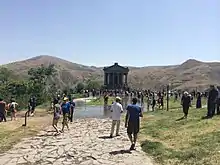
The temple is the most significant structure in Armenia from the pre-Christian period and has become a symbol of this era.[43][75] Maranci describes it as one of the most celebrated monuments of ancient Armenia.[31] Furthermore, it is the sole standing Greco-Roman colonnaded building in Armenia and the former Soviet Union.[lower-alpha 8] It became a tourist destination even before its reconstruction in the 1970s.[80] Today, it is, along with the nearby medieval monastery of Geghard, one of the main tourist attraction sites in Armenia.[81][82] Most people visiting Garni also visit Geghard.[83] The two sites are often collectively known as Garni-Geghard (Գառնի-Գեղարդ).[84] In 2013 some 200,000 people visited the temple.[85]
In recent years many notable individuals have visited the temple, such as Presidents of Cyprus (Demetris Christofias),[86] Austria (Heinz Fischer),[87] Greece (Karolos Papoulias),[88] Spanish opera singer Montserrat Caballé,[89] American TV personalities Khloé and Kim Kardashian,[90] and American comedian Conan O'Brien.[91] O'Brien, who visited the temple in October 2015 with his Armenian assistant Sona Movsesian, filmed an episode in Armenia which included dancing at the temple of Garni.[92] The episode aired on his late-night talk show on November 17, 2015 and scored 1.3 million viewers.[93][94]
Preservation
The temple and the fortress are part of the Garni Historical and Cultural Museum Reserve (Armenian: «Գառնի» պատմա-մշակութային արգելոց-թանգարան), which occupies 3.5 hectares (8.6 acres) and is supervised by the Service for the Protection of Historical Environment and Cultural Museum Reservations, an agency attached to the Ministry of Culture of Armenia.[85] The list of intangible historical and cultural monuments approved by the government of Armenia includes 11 items within the area.[9]
.png.webp)
In a 2006 survey the state of conservation of Garni was rated by over three-quarters of the visitors as "good" or "very good".[83] In 2011 UNESCO awarded the Museum-Reservation of Garni the Melina Mercouri International Prize for the Safeguarding and Management of Cultural Landscapes for "measures taken to preserve its cultural vestiges, and the emphasis placed on efforts to interpret and open the site for national and international visitors."[95]
On September 25, 2014 Maksim Nikitenko, a Russian tourist in his early 20s, defaced the temple[96] by spray painting "В мире идол ничто" (literally translating to "In the world, idol is nothing").[97][98] The painting was cleaned days later.[99] The Armenian state service for protection of historical and cultural reserves filed a civil lawsuit against Nikitenko in February 2015, in which the agency requested 839,390 AMD (~$1,760) to recover the damage resulting from vandalism.[100] In an April 2015 decision the Kotayk Province court ruled to take Nikitenko into custody for 2 months and fine him the requested amount.[101]
Neopagan shrine
Since 1990,[102] the temple has been the central shrine[103][104] of the small number of followers of Armenian neopaganism (close to Zoroastrianism) who hold annual ceremonies at the temple,[105] especially on March 21—the pagan New Year.[102][106] On that day, which coincides with Nowruz, the Iranian New Year, Armenian neopagans celebrate the birthday of the god of fire, Vahagn.[107] Celebrations by neopagans are also held during the summer festival of Vardavar, which has pre-Christian (pagan) origins.[108][109]
Notable events
The square in front of the temple is a site of occasional concerts. In 1985 the Soviet televised music festival Pesnya goda ("Song of the Year") was recorded at the temple.[110]
In 1985 some scenes of Polish movie Travels of Mr. Kleks were shot at the Garni temple.[112]
The torch of the first Pan-Armenian Games was lit near the temple on August 28, 1999.[113]
Another concert was held near the temple on July 2, 2004 by the National Chamber Orchestra of Armenia, conducted by Aram Gharabekian.[114] The orchestra played the works of Aram Khachaturian, Komitas, Edvard Mirzoyan, Strauss, Mozart, and other composers.[115]
On May 6, 2019 Acid Pauli performed a live concert of electronic music in front of the temple.[116]
On July 14, 2019 the National Chamber Orchestra of Armenia performed a concert in front of the temple dedicated to the 150th anniversaries of Komitas and Hovhannes Tumanyan.[117]
Gallery
See also
References
- Notes
- Also called Գառնու/Գառնիի հեթանոսական տաճար Gaṙnu/Gaṙnii het’anosakan tačar, lit. "pagan temple of Garni".
- Armenian: Գառնիի ամրոց, Gařnii amrots or Գառնու ամրոց, Gařnu amrots
- "on a block of basalt 165 cm long, 50 cm high, and 79–80 cm thick; the letters are about 5 x 5.5 cm in size."[5]
- This date was proposed by Alexander Sahinian[19] and has since gained general acceptance.[20] Early medieval historian Movses Khorenatsi incorrectly attributed the inscription to Tiridates III.[18]
- After the Roman–Parthian War over Armenia (58–63) a peace treaty was signed according to which Tiridates would be crowned by Nero and thus became an ally of Rome.[21] In exchange, Rome recognized Armenia's independence.[22]
- The traditional date is 301 AD,[32] first calculated by historian Mikayel Chamchian.[33] A growing number of authors argue that the correct date is 314 by citing the Edict of Milan.[34][35] Elizabeth Redgate writes that "the scholarly consensus is to prefer c. 314."[36]
- "The monuments of Garni are the only vestiges of the pagan architecture of Armenia known to us. [...] The most important ruins are those of the temple"[38]
"on the threshold of adopting Christianity as state religion, all pagan cultic structures (except the temple of Garni) were mercilessly destroyed"[39]
"Armenia's only remaining pagan temple, at Garni"[40]
"Գառնիի ճարտարապետական համալիրի անգին զարդն է տաճարը՝ հեթանոս հայության ճարտարապետական ժառանգությունից պահպանված միակ հիշատակարանը"[41]
"The obliteration of pagan vestiges was so complete that almost no architectural remains or temple records have survived ... The only exception is the Temple of Garni"[37] - Variously described as:
- "the only Greco-Roman colonnaded building anywhere in the Soviet Union"[2]
- "the only Greco-Roman temple standing above ground in the entire Soviet Union"[76]
- "the sole pagan temple of the Hellenic type in the territory of the Soviet Union"[77]
- References
- Khatchadourian 2008, p. 251.
- Smith, Adam T. (2012). "'Yerevan, My Ancient Erebuni': Archaeological Repertoires, Public Assemblages, and the Manufacture of a (Post-)Soviet Nation". In Charles W. Hartley; G. Bike Yazicioğlu; Adam T. Smith (eds.). The Archaeology of Power and Politics in Eurasia: Regimes and Revolutions. Cambridge University Press. p. 65. ISBN 9781107016521.
the unique temple-tomb at Garni, just east of Yerevan – the only Greco-Roman colonnaded building anywhere in the Soviet Union.
- "Garni, Armenia". elevationmap.net.
- Hakobian, T. Kh.; Melik-Bakhshian, St. T.; Barseghian, H. Kh. (1986). "Գառնիի տաճար [Temple of Garni]". Հայաստանի և հարակից շրջանների տեղանունների բառարան [Dictionary of Toponyms of Armenia and Surrounding Regions] Volume I (in Armenian). Yerevan University Press. p. 704.
- Russell 1987, p. 269.
- Hewsen, Robert H. (2001). Armenia: A Historical Atlas. Chicago: University of Chicago Press. p. 62. ISBN 978-0-226-33228-4.
a large Ionic building usually taken for a temple but whose survival, and the fact that in the seventh century a church was built next to it rather than in its place, suggests that it was more likely the tomb of one of the Roman-appointed kings of Armenia, perhaps Tiridates I (51–60; 63-p. 75) or Sohaimos of Emesa (140–160).
- Khatchadourian 2008, p. 252.
- Kiesling 2000, p. 52.
- "Հայաստանի Հանրապետության Կոտայքի մարզի պատմության և մշակույթի անշարժ հուշարձանների պետական ցուցակ". arlis.am (in Armenian). Armenian Legal Information System. 24 December 2003. Archived from the original on 12 January 2015.
- Kiesling 2000, p. 51.
- Abrahamian 1947, p. 61.
- Manandian, Hakob (1946). Գառնիի հունարեն արձանագրությունը և Գառնիի հեթանոսական տաճարի կառուցման ժամանակը [The Greek inscription of Garni and the construction date of the pagan temple of Garni] (in Armenian). Yerevan: State University Press. (PDF)
- Tananyan 2014, pp. 31–32.
- Abrahamian 1947, p. 66.
- Russell 1987, pp. 269-270.
- Ananian, Poghos (1994). "Գառնիի Յունարէն արձանագրութիւնը [The Greek inscription of Garni]". Bazmavep (in Armenian). San Lazzaro degli Armeni: Mekhitarist Order. 152: 111. cited and translated in Nersessian 2001, p. 103
- Russell 1987, pp. 269-270.
- Nersessian 2001, p. 101.
- Sahinian, Alexander (1983). Գառնիի անտիկ կառույցների ճարտարապետությունը [Architecture of antique constructions of Garni] (in Armenian). Yerevan: Armenian SSR Academy of Sciences Publishing.
- Tananyan 2014, pp. 33–34.
- Dando-Collins, Stephen (2010). The Great Fire of Rome: The Fall of the Emperor Nero and His City. Cambridge, Massachusetts: Da Capo Press. p. 15. ISBN 978-0306818905.
- Tananyan 2014, p. 34.
- Tananyan 2014, p. 35.
- Petrosyan, Hamlet (2001). "Symbols of Armenian Identity: The Temple". In Abrahamian, Levon; Sweezy, Nancy (eds.). Armenian Folk Arts, Culture, and Identity. Bloomington: Indiana University Press. p. 43. ISBN 9780253337047.
The only surviving Hellenistic temple, the wonderful ionic-columned temple of Garni was built in the 1st century AD and dedicated to the sun god, Mithra (Mihr in Armenian).
- Bauer-Manndorff 1981, p. 72.
- Tananyan 2014, p. 39.
- Fetvadjian, Arshag (1964) [1958]. "Architecture in Armenia". In Kurkjian, Vahan (ed.). A History of Armenia. New York: Armenian General Benevolent Union of America. p. 426.
- Report by Kamilla Trever cited in Field, Henry; Price, Kathleen (1950). "Archaeological News, Russia". American Journal of Archaeology. 54 (4): 427. doi:10.2307/501010. JSTOR 501010.
- Wilkinson 1982, pp. 221-244.
- Russell 1987, p. 270.
- Maranci, Christina (2018). The Art of Armenia: An Introduction. Oxford University Press. pp. 26–27. ISBN 978-0190269005.
- Balakian, Peter (2009). The Burning Tigris. New York: HarperCollins. p. 29. ISBN 978-0-06-186017-1.
- Panossian 2006, p. 106.
- Panossian 2006, p. 42.
- Hastings, Adrian; Mason, Alistair; Pyper, Hugh, eds. (2000). The Oxford Companion to Christian Thought. Oxford University Press. p. 39. ISBN 978-0-19-860024-4.
- Redgate, A. E. (2000). The Armenians. Oxford: Blackwell Publishing. p. 314. ISBN 9780631220374.
- Hacikyan, Agop Jack; Basmajian, Gabriel; Franchuk, Edward S.; Ouzounian, Nourhan (2000). The Heritage of Armenian Literature: From the Oral Tradition to the Golden Age. Detroit: Wayne State University Press. p. 80. ISBN 9780814328156.
The obliteration of pagan vestiges was so complete that almost no architectural remains or temple records have survived ... The only exception is the Temple of Garni...
- Der Nersessian, Sirarpie (1969). The Armenians. New York: Praeger. p. 99.
The monuments of Garni are the only vestiges of the pagan architecture of Armenia known to us. [...] The most important ruins are those of the temple built during the reign of Trdat I, shortly after ad 66, and which had survived until it was destroyed by an earthquake in 1679.
- Grigoryan, Vahagn (2014). "Հայաստանի ճարտարապետության պատմության հիմնովին վերանայման խնդիրը [The Problem of Fundamental Revising the History of Armenian Architecture]". Patma-Banasirakan Handes (in Armenian). № 1 (1): 20.
- Berman, Michael (2008). The Shamanic Themes in Armenian Folktales. Newcastle upon Tyne: Cambridge Scholars Publishing. p. 34. ISBN 9781847186218.
- Tananyan 2014, p. 31.
- Nersessian 2001, p. 100: "The pagan temple of Garni, dedicated to the god Mihr, is the only surviving Hellenistic building built by King Trdat I about 77 BC."
- Holding, Deirdre (2014) [2003]. Armenia: with Nagorno Karabagh (4th ed.). Bradt Travel Guides. p. 40. ISBN 9781841625553.
By far the best known pre-Christian building is the sole-surviving example of Graeco-Roman architecture in Armenia, built at Garni...
- Tananyan 2014, p. 32.
- Arakelian, B.N.; Karakhanian, G.H. (1962). Գառնի. 1949-1956 պեղումների արդյունքները [Garni. Volume III: Results of excavations of 1949-1956] (in Armenian). Yerevan: Armenian SSR Academy of Sciences Publishing. p. 45.
- Tananyan 2014, p. 44.
- Ghazinyan, A. A. (1974). "Դիմառնությունը միջնադարյան հայ բանաստեղծության մեջ [Impersonation in medieval Armenian literature]". Lraber Hasarakakan Gitutyunneri (in Armenian). № 5 (5): 40.
- Hakobyan, Tadevos (1979). Երևանի պատմությունը (1500–1800 ԹԹ.) [History of Yerevan (1500-1800)] (in Armenian). Yerevan State University Press. p. 327.
...երկրաշարժը տեղի է ունեցել 1679 թվականի հունիսի 4-ին։
- Piruzyan, S. A. (2011). "Effects of multifocus earthquakes on seismic motion". Seismic Instruments. 47 (2): 118. doi:10.3103/S0747923911020071.
1679 Yerevan (Garni) earthquake (M = 7.0, I = 9). The focus was located near Garni village, which is 20 km east of Yerevan. Historian eyewitnesses wrote a very detailed description of the event’s consequences, which were catastrophic in Yerevan and the settlements closest to the epicenter. The pagan Trdata Temple in Garni village was destroyed. This temple had been built in the 1st century and had a traditional ancient construction, namely, a massive floor supported by 12 stone columns placed along the perimeter of an elevated podium. The columns could not withstand the repeated quakes, and the entire colonnade of the temple collapsed.
- Guidoboni, E.; Haroutiunian, R.; Karakhanian, A. (2003). "The Garni (Armenia) large earthquake on 14 June 1679: a new analysis". Journal of Seismology. Kluwer Academic Publishers. 7 (3): 302. doi:10.1023/A:1024561622879.
- Hasrat'yan, Mourad (1995). "The medieval earthquakes of the Armenian Plateau and the historic towns of Ayrarat and Shirak (Dvin, Ani, Erevan)". Annali di Geofisica. Italian National Institute of Geophysics. 38 (5–6): 721.
- Lang 1970, p. 146.
- Morier, James (1818). A second journey through Persia, Armenia, and Asia Minor, to Constantinople, between the year 1810 and 1816. London: Longman. p. 339–340.
- Porter 1821, p. 626.
- Porter 1821, p. 624.
- Porter 1821, p. 627.
- Strzygowski 1918, p. 13.
- Color pictures from before reconstruction can be found here.
- Strzygowski 1918, p. 344.
- Khatchadourian 2008, p. 256.
- Tananyan 2014, p. 33.
- Donabédian, Patrick (2012). "Les architectes de l'Arm´enie m´edi´evale usaient-ils de dispositifs parasismiques ?". Revue des Études Arméniennes (in French): 172.
On pourrait en dire autant du temple antique de Garni, dont une partie des maçonneries a été jetée dans le ravin lors du séisme de 1679 (puis remontée avant sa reconstruction en 1969-75 par Alek‘sandr Sahinyan).
- ""Գառնի" պատմա- մշակութային արգելոց-թանգարան ["Garni" Historical-Cultural Museum-Reservation]". hushardzan.am (in Armenian). Service for the Protection of Historical Environment and Cultural Museum-Reservations, Ministry of Culture of the Republic of Armenia.
- Tananyan 2014, p. 37.
- Bauer-Manndorff 1981, p. 65: "Although at first glance the temple of Garni would seem alien to Armenian architecture, it is not purely Hellenistic for it also follows ancient local traditions."
- Tananyan 2014, pp. 41–42.
- Khatchadourian 2008, p. 272.
- Sahinyan, Alekʻsandr (1983). Gaṛnii antik kaṛuytsʻneri chartarapetutʻyuně [Architcture of the ancient structures of Garni]. Armenian SSR Academy of Sciences Publishing. p. 235.
Thus, peripteral composition of the Garny temple as a product of the architectural-constructional art of the Hellenistic period, by its entire structure resembles the Urartian temple of Musasir (IX с. В. C).
- Arakelyan, Babken (1968). "Excavations at Garni, 1949–1950". In Alekseyev, Valery (ed.). Contributions to the archaeology of Armenia. Cambridge, Massachusetts: Peabody Museum of Archaeology and Ethnology. p. 22.
The temple is peripteral, built on a high podium, with 24 Ionic columns, 6 in front and back and 8 at each side; the corner columns are listed twice. It is constructed of gray basalt quarried at Garni.
- Tananyan 2014, p. 41.
- Tananyan 2014, p. 38.
- "Fragment of a carved black basalt frieze". British Museum.
- "Храм Гарни и монастырь Гехард, Армения". ru-travel.livejournal.com (in Russian). 31 October 2013.
Если здесь когда-то и проводились кровавые ритуалы, то больше 20 человек внутри храма при этом не присутствовали.
- Tananyan 2014, pp. 38–39.
- Stokes, Jamie, ed. (2009). "Armenians". Encyclopedia of the Peoples of Africa and the Middle East. Infobase Publishing. p. 62. ISBN 9781438126760.
Despite the dearth of surviving pre-Christian architecture, several sites have allowed archaeologists to learn something about the general pattern of pre-Christian building in Armenia. The most important of these is the site at Garni...
- Kouymjian, Dickran. "Temple of Garni". California State University, Fresno Armenian Studies Program. Archived from the original on 28 May 2013.
It was restored in the 1970s and has the distinction of being the only Greco-Roman temple standing above ground in the entire Soviet Union.
- Krymskiy, Mark (3 February 2011). "Старая Армения" (in Russian). Gazeta.ru.
...храм Гарни --единственный на территории СССР языческий храм эллинистического типа...
- Bernhard, M. L.; Sztetyłło, Z. (1976). "OLBIA Ukraine". The Princeton Encyclopedia of Classical Sites.
...a temple of Apollo Delphinios (30-35 x 16 m) of the 4th-2d c. completely surrounded by porticos of Ionian columns...
- Wilson, Nigel (2013). "Olbia". Encyclopedia of Ancient Greece. Routledge. p. 510. ISBN 9781136788000.
...the Ionic temple of Apollo Delphinios...
- Lang 1970, p. 144.
- Karanian, Matthew (8 May 2013). "Beyond Geghard And Garni". Asbarez.
First-time travelers to Armenia seem to always end up at Echmiadzin, Khor Virap, Geghard, and Garni.
- "The number of foreign tourists visiting Armenia expected to surge to one million". ARKA News Agency. 30 June 2014.
Foreign tourists usually visit the pagan temple of Garni, Geghard Monastery, Holy Etchmiadzin and Lake Sevan.
- Alberini, Anna; Longo, Alberto (2006). "Combining the travel cost and contingent behavior methods to value cultural heritage sites: Evidence from Armenia". Journal of Cultural Economics. Springer Science+Business Media. 30 (4): 293. JSTOR 41810931.
- "Գառնի-Գեղարդ. Հայաստանի մարգարիտները՝ իրենց գույներով". azatutyun.am (in Armenian). Radio Free Europe/Radio Liberty. 16 May 2012.
- Petrosyan, Sara (21 February 2014). "Crime of Culture: Government Neglect and New Café Ensure that Garni Will Never Become a UNESCO World Heritage Site". Hetq Online.
- "With warm feelings and bright impressions". Hayastani Hanrapetutyun. 8 July 2009.
- Mehrabyan, Tigran (27 June 2012). "Ավստրիայի նախագահ Հեյնց Ֆիշերի այցը Գառնու տաճար և Գեղարդի վանք" (in Armenian). PanARMENIAN.Net.
- "Greek President arriving in Armenia on state visit". ArmeniaNow. 29 September 2014.
- Ghazanchyan, Siranush (12 June 2013). "Montserrat Caballe visits Garni Temple and Geghard Monastery". Public Radio of Armenia.
- "International Press Coverage of Kim Kardashian's Visit to Armenia". civilnet.am. 10 April 2015.
On April 9, Kim and Khloe Kardashian visit several sites in Yerevan and later went to the historic sites of the first century A.D. Garni Temple and Geghard Monastery...
- "Conan O'Brien visits Armenia". news.am. 13 October 2015. Facebook photo
- "Conan Dances At The Garni Temple - CONAN on TBS". Team Coco on YouTube. 18 November 2015.
- "Show Schedule". teamcoco.com. 17 November 2015.
- "#ConanArmenia Scores 1.3 Million Viewers". Asbarez. 19 November 2015.
- "Armenian and Palestinian sites share 2011 cultural landscape prize". unesco.org. UNESCOPRESS. 12 May 2011.
- "Iravunk: Investigation into Russian tourist case continues". aysor.am. 3 October 2010.
- Турист из Москвы исписал языческий храм в Армении. Gazeta.ru (in Russian). 26 September 2014.
- ՌԴ քաղաքացին պղծել է Գառնու տաճարը. A1plus (in Armenian). 26 September 2014.
- Գառնիի տաճարի վրա ռուս զբոսաշրջիկի գրառումը մաքրվել է. Tert.am (in Armenian). 1 October 2014.
- "Армения потребовала более $1700 c осквернившего языческий храм россиянина" (in Russian). Interfax. 11 February 2015.
- "Гражданин России, исписавший краской храм в Армении, отделался штрафом" (in Russian). REGNUM News Agency. 17 April 2015.
- "Ամանորը և Վահագնի ծնունդը՝ մարտի 21-ին". Aravot (in Armenian). 19 March 2011.
Արորդիների ուխտը 1990–ից ի վեր Ամանորն ավանդաբար տոնում է Գառնիի տաճարում: Այս տարի նույնպես Ամանորի ծիսակատարությունը կսկսվի մարտի 21-ի կեսօրին՝ Գառնիում:
- Antonyan, Yulia. ""Արորդիների ուխտ"' նեոհեթանոսությունը Հայաստանում [Neopaganism in Armenia]". religions.am (in Armenian). Religions in Armenia.
Հայաստանում պահպանված և 1975թ. վերականգնված մինչքրիստոնեական Միհր աստծու տաճարը Գառնիում վերածվեց նեոհեթանոսների ծիսակատարությունների հիմնական վայրի:
- Aitamurto, Kaarina; Simpson, Scott (2014). "Sacred Landscapes". Modern Pagan and Native Faith Movements in Central and Eastern Europe. Routledge. ISBN 978-1844656622.
- Antonyan, Yulia (2010). ""Reconstituting" Religion: Neo-Paganism in Armenia. Summary". Laboratorium: Russian Review of Social Research. Saint Petersburg (1). ISSN 2078-1938. Archived from the original on January 11, 2015.
- Melkumian, Hrach (21 March 2002). "Pagan Cult Marks Ancient Festival". azatutyun.am. RFE/RL.
- Melkumian, Hrach (21 March 2002). "Pagan Cult Marks Ancient Festival". RFE/RL.
- Krikorian, Onnik (26 July 2007). "Armenian Festival Combines Paganism and Nationalism". eurasianet.org. Open Society Institute.
- "Vardavar Celebrations in Garni". Hetq Online. 8 July 2013.
- Kozachenko, Tatyana (7 February 2012). "Древние храмы из камня в Каменной стране [Ancient stone temples in the Stone country]". Vokrug sveta (in Russian).
- "Banknotes out of Circulation - 5000 drams". Central Bank of Armenia.
- https://gadzetomania.pl/212,witajcie-w-naszej-bajce-akademia-pana-kleksa-ma-30-lat
- "First Pan Armenian Game's Torch to Be Lit in Garni". Asbarez. 28 August 1999.
- Abrahamyan, Gayane (2 July 2004). "Nature Worship: Sounds and sights make a special night in Garni". ArmeniaNow.
- "Բացօթյա համերգ Գառնիում". Aravot (in Armenian). 26 June 2004.
Կկատարվի Արամ Խաչատրյան, Կոմիտաս-Ասլամազյան, Էդվարդ Միրզոյան, Շտրաուս, Մոցարտ եւ այլն:
- "Acid Pauli live @ Garni Temple". Cercle on Facebook. 6 May 2019.
- "Komitas & Hovhannes Tumanyan-150. Garni Temple". chambermusiccenter.am. 22 June 2019. Archived from the original on 11 December 2019.
Bibliography
- Abrahamian, A. G. (1947). Գառնիի հունարեն արձանագրությունը [The Greek inscription o Garni]. Etchmiadzin (in Armenian). 4 (3–4): 61–72.
- Khatchadourian, Lori (2008). "Making Nations from the Ground up: Traditions of Classical Archaeology in the South Caucasus". American Journal of Archaeology. 112 (2): 247–278. doi:10.3764/aja.112.2.247. JSTOR 20627449.
- Tananyan, Grigor (2014). Գառնի պատմամշակութային կոթողը (տաճարի վերականգման 40-ամյակի առթիվ) [The Historic & Cultural Monument of Garni (to the 40th anniversary of the restoration of the temple)]]. Patma-Banasirakan Handes (in Armenian). № 2 (2): 25–45.
- Panossian, Razmik (2006). The Armenians: From Kings and Priests to Merchants and Commissars. New York: Columbia University Press. ISBN 9780231139267.
- Nersessian, Vrej (2001). Treasures from the Ark: 1700 Years of Armenian Christian Art. Los Angeles: J. Paul Getty Museum. ISBN 9780892366392.
- Bauer-Manndorff, Elisabeth (1981). Armenia: Past and Present. Lucerne: Reich Verlag.
- Russell, James R. (1987). Zoroastrianism in Armenia. Cambridge, Massachusetts: Harvard University Press. ISBN 978-0-674-96850-9.
- Strzygowski, Josef (1918). Die Baukunst der Armenier und Europa [The Architecture of the Armenians and of Europe] Volume 1 (in German). Vienna: Kunstverlag Anton Schroll & Co.
- Porter, Robert Ker (1821). Travels in Georgia, Persia, Armenia, ancient Babylonia, &c. &c. Volume II. London: Longman, Hurst, Rees, Orme, and Brown.
- Kiesling, Brady (2000). Rediscovering Armenia: An Archaeological/Touristic Gazetteer and Map Set for the Historical Monuments of Armenia (PDF). Yerevan/Washington DC: Embassy of the United States of America to Armenia. Archived from the original (PDF) on 2006-05-03.
- Lang, David Marshall (1970). Armenia: Cradle of Civilization. London: Allen & Unwin.
- Wilkinson, R. D. (1982). "A Fresh Look at the Ionic Building at Garni". Revue des Études Arméniennes (XVI).
Further reading
- Manandyan, Hakob (1951). "Новые заметки о греческой надписи и языческом храме Гарни". Bulletin of the Academy of Sciences of the Armenian SSR: Social Sciences (in Russian). № 4 (4): 9–36.
- Bartikian, Hrach (1965). "Գառնիի հունարեն անձանագրությունը և Մովսես Խորենացին [The Greek Inscription of Garni and Movses Khorenatsi]". Patma-Banasirakan Handes (in Armenian). № 3 (3): 229–234.
- Mouradian, G. S. (1981). "Греческая надпись Трдата I, найденная в Гарни [Tiridates I's Greek Inscription Discovered in Garni]". Patma-Banasirakan Handes (in Russian). № 3 (3): 81–94.
- Sahinian, Alexander (1979). "Գառնիի անտիկ տաճարի կառուցման ժամանակը [The Time of the Construction of the Antique Temple of Garny]". Patma-Banasirakan Handes (in Armenian). № 3 (3): 165–181.
- Sahinian, Alexander (1979). "Գառնիի անտիկ տաճարի վերակազմության գիտական հիմունքները [Scientific Foundations of the Reconstruction of the Ancient Temple of Garny]". Patma-Banasirakan Handes (in Armenian). № 4 (4): 135–155.
- Sahinian, Alexander (1979). "Գառնիի անտիկ տաճարի վերականգնումը [The Reconstruction of the Ancient Temple of Garni]". Lraber Hasarakakan Gitutyunneri (in Armenian). № 10 (10): 59–74. ISSN 0320-8117.
- Sahinian, Alexander (1979). "Գառնիի անտիկ տաճարի համաչափական համակարգը [Proportional System of the Ancient Temple of Garni]". Lraber Hasarakakan Gitutyunneri (in Armenian). № 12 (12): 76–92. ISSN 0320-8117.
- Sargsian, Harma (1982). "Գառնիի հեթանոսական տաճարի վերականգնման ճարտարագիտական հարցերը [Engineering questions of the restoration of paganish temple of Garni]". Lraber Hasarakakan Gitutyunneri (in Armenian). № 12 (12): 70–76. ISSN 0320-8117.
- Sahinian, Alexander (1983). Գառնիի անտիկ կառույցների ճարտարապետությունը [Architecture of ancient structures of Garni] (in Armenian). Yerevan: Armenian SSR Academy of Sciences Publishing.
- Sahinian, Alexander (1988). Архитектура античных сооружений Гарни [Architecture of ancient structures of Garni] (in Russian). Yerevan: Sovetakan Grogh.
External links
| Wikimedia Commons has media related to Garni Temple. |
- "Arménie : Le temple de Garni au son du duduk". Le Monde (in French). 14 June 2011.
- "Лекция "Храм в Гарни и искусство эллинистической Армении"" (in Russian). State Museum of the Orient. 29 September 2015.
- Garni at Armenica.org
- Description at Cilicia.com
.png.webp)
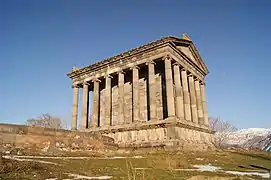
%252C_Armenia_(30627458817).jpg.webp)
%252C_Armenia_(30627457797).jpg.webp)
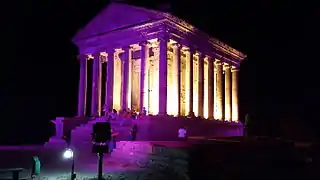
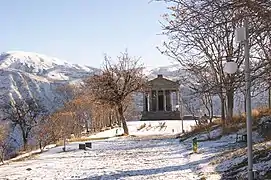

.jpg.webp)
